Apple MacBook Pro (M1) Vs. Microsoft Surface Book 3
CRN compares Apple’s 13-inch MacBook Pro with the M1 chip against Microsoft’s latest Surface Book convertible laptop, featuring 10th-gen Intel Core processors and optional Nvidia GeForce graphics.
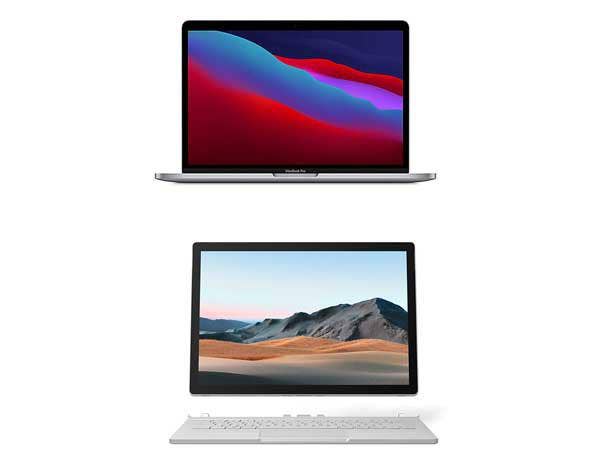
Head-To-Head
Apple is seeking to turn up the heat on its PC rivals with the launch of its M1 processor in its latest Macs, including the 13-inch MacBook Pro. While many Windows 10 laptops, such as the Microsoft Surface Book 3, continue to be powered by Intel Core processors, Apple has brought forward its high-performance M1 chip in a bid to crush the PC competition on speed. But does the new MacBook Pro with M1 really deliver? And what about other key features and specs, such as battery life, display and portability? Notably, Microsoft’s Surface Book 3 does have some unique features to offer that you won’t find on the M1 MacBook Pro, especially when it comes to the display and graphics. For instance, on GPU, the Surface Book 3 can be outfitted with a high-powered discrete graphics card, up to the Nvidia GeForce GTX 1660 Ti. The Surface Book 3 with 10th-gen Intel chips is still a performance heavyweight when it comes to CPU performance, too—and can also be configured with a higher amount of RAM than the M1 MacBook Pro. Clearly, the new MacBook Pro with M1 and Surface Book 3 are the professional-tier notebooks from Apple and Microsoft, in contrast to the more consumer-oriented MacBook Air and Surface Laptop 4. But which of the notebooks, the MacBook Pro with M1 or the Surface Book 3, is ideal for you?
In the following slides, the CRN Test Center compares the Apple MacBook Pro (M1) vs Microsoft’s Surface Book 3 on price, key features and specs.
Display
It’s not likely that you’ll be disappointed with the display quality on either the 13.3-inch MacBook Pro with M1 or the Surface Book 3. Both notebooks offer terrific LCD displays, with colorful and vibrant screen technology—Apple’s Retina display for the MacBook Pro and Microsoft’s PixelSense technology on the Surface Book 3 display. But the Surface Book 3 stands out in a few ways when it comes to the display. For starters, the Surface Book 3 display is a touch screen, whereas the MacBook Air with M1 (like all other Macs) does not offer a touch option. The Surface Book 3 also comes in two different sizes—a smaller model that has a 13.5-inch display and a larger version with a 15-inch screen. By contrast, while the MacBook Pro is also available in a larger size—at 16 inches—that model does not yet come with the M1 processor. (Rumors suggest that Apple is waiting to update its 16-inch MacBook Pro with the next generation of its M-series processor, possibly called the M1X or M2.)
But the size options and touch screen are not even the most striking differences on display for the M1 MacBook Pro vs the Surface Book 3 comparison. Rather, it’s the fact that Microsoft’s Surface Book 3 offers a unique design that lets you detach the display from the keyboard base. You can then use the display as a standalone tablet, or flip the display around and re-attach it to the base facing the other direction for use in presentation mode or stand mode.
In terms of resolution, the Surface Book 3 offers a bit more in the way of pixels, potentially enabling a crisper image. The 13.5-inch model offers display resolution of 267 pixels per inch (ppi), while the 15-inch Surface Book 3 features resolution of 260 ppi. The M1 MacBook Pro offers screen resolution of 227 ppi.
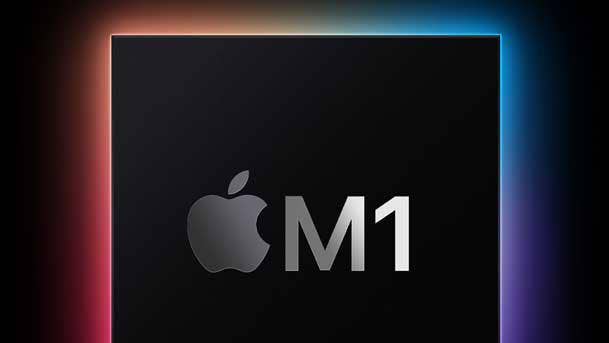
CPU, GPU and RAM
The 13-inch MacBook Pro is among the first devices to come equipped with Apple’s high-performance M1 processor. The M1 is an Arm-based chip featuring an eight-core CPU and an eight-core GPU. The eight-core CPU consists of four cores focused on offering strong performance for demanding tasks, along with four cores that enable battery efficiency for less-intensive tasks.
Microsoft’s Surface Book is powered by quad-core, 10th-gen Intel Core processors. For the 13.5-inch model, there are two choices—the Core i5 (specifically the i5-1035G7) or the Core i7 (the i7-1065G7). The 15-inch model is only available with the Core i7-1065G7. The Surface Book 3 processors are from Intel’s previous generation of chips, with the latest Intel Core processors coming from the company’s 11th-gen portfolio.
For CPU performance, benchmark scores point to a major performance advantage for the MacBook Pro with M1, even when it’s facing off with the fastest Surface Book 3. Geekbench 5 scores for Apple’s M1 and Intel’s Core i7-1065G7 show the M1 coming out well ahead in both single-core and multi-core CPU benchmarks. The M1’s CPU performance advantage should be most apparent on more-demanding, multi-core tasks, according to the Geekbench 5 results.
But GPU performance is another story—something that should be of note to anyone looking to use their laptop for gaming. Only the Surface Book 3 has an option for discrete graphics. The 13.5-inch model (with Core i7) comes equipped with Nvidia’s GeForce GTX 1650 with Max-Q (offering 4 GB of GDDR5 graphics memory). The 15-inch model goes even bigger on graphics capabilities, with Nvidia’s GeForce GTX 1660 Ti with Max-Q and 6 GB of GDDR6 graphics memory. Benchmarks from GFXBench 4.0 show a GPU advantage for either graphics card—but especially for the GeForce GTX 1660 Ti, which offers significantly stronger GPU performance across a number of different tests, according to the benchmarks.
Additionally, the Surface Book 3 gets a further performance boost from its option for including up to 32 GB of RAM. The 13.5-inch model can be configured with 8 GB, 16 GB or 32 GB of RAM, while the 15-inch model is available with 16 GB or 32 GB. The M1 MacBook Pro is offered with 8 GB or 16 GB of RAM.
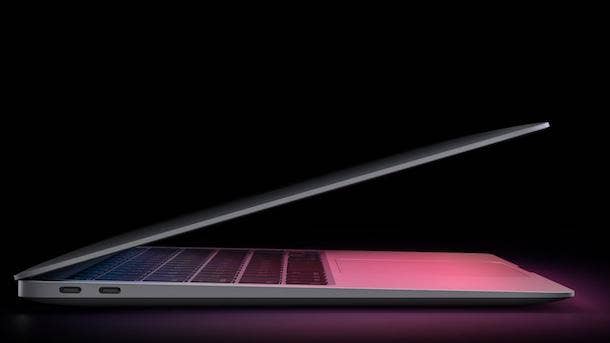
Portability and Chassis
While both devices in our comparison are workhorses on performance, neither is going to rank high on any lists of the most-portable laptops. Still, the 13-inch MacBook Pro with M1 does come out ahead on portability, with its weight of 3 pounds and thickness of 0.61 of an inch. The starting weight for the Surface Book 3 is 3.38 pounds (for the 13.5-inch model with Core i5). The 13.5-inch model with Core i7 weighs in at 3.62 pounds, while the 15-inch Surface Book 3 is a full 40-percent heavier than the M1 MacBook Pro, at 4.2 pounds. All variants of the Surface Book 3 measure 0.9 of an inch thick on the hinge side of the laptop.
In terms of the metals used in the chassis of each laptop, the MacBook Pro is made from aluminum while the Surface Book 3 opts for magnesium. On colors, the MacBook Pro with M1 has two choices—Silver or Space Gray—while the Surface Book 3 comes only in Platinum.
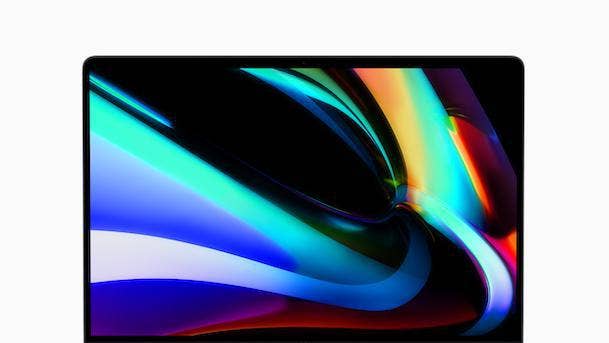
Collaboration and Battery Life
With video and audio conferencing now a bigger focus for so many workers, Apple has outfitted the M1 MacBook Pro with several collaboration-friendly updates. Those include the addition of a “studio-quality” array of three mics, along with Apple’s latest camera image signal processor—which enables sharper images and “more detail in shadows and highlights on video calls”—for the notebook’s 720p FaceTime HD camera, according to the company. The MacBook Pro also offers stereo speakers with support for Dolby Atmos playback.
The Surface Book 3 offers an even higher-resolution front-facing webcam, though, which enables 1080p HD video. A rear-facing camera offers 1080p HD video, as well. Other collaboration features include dual far-field “studio” mics and stereo speakers with Dolby Atmos.
On battery life, both notebooks promise long usage times without needing to recharge. Microsoft is promising up to 17.5 hours of usage for 15-inch Surface Laptop 3, while the 13.5-inch model offers battery life of up to 15.5 hours, according to the company.
Those impressive figures are actually surpassed by the M1-powered MacBook Pro, however—with Apple promising up to 20 hours of battery life for the MacBook Pro with M1. That’s thanks in large part to the M1 itself, which includes four high-efficiency cores for conserving the battery. To put the M1’s capabilities on power conservation in perspective, the 13-inch MacBook Pro with Intel promises only half that amount of battery life—10 hours.
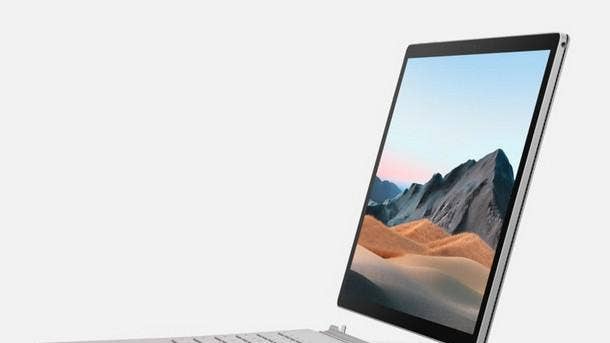
Ports and Storage
In terms of ports, the Surface Book 3 offers greater variety than the MacBook Pro with M1, which features two Thunderbolt / USB-C ports only. By contrast, the Surface Book 3 comes with one USB-C port, two USB-A ports and a full-size SD card slot. Thus, buyers of the Surface Book 3 are somewhat less likely to need to carry around dongles for their connector needs.
On storage, the MacBook Pro and the 15-inch Surface Book 3 have identical SSD options—256GB, 512GB, 1TB or 2TB. The 13.5-inch Surface Book 3 is configurable with 256GB, 512GB or 1TB of SSD. Both Apple and Microsoft have touted major gains on SSD speed—with Apple ascribing faster SSD speeds to the use of the M1 chip and Microsoft touting the Surface Book 3’s solid-state drive as “the fastest SSD we have ever shipped.”

Price
Despite Apple’s reputation as the maker of steeply priced devices, the 13-inch MacBook Pro with M1 is easily the more affordable laptop in this comparison. The notebook has a starting price of $1,299—whereas Microsoft’s Surface Book 3 starts $300 higher at $1,599.99. And, it must be noted that this is pricing for the smaller 13.5-inch model with the lowest-performance processor—the Intel Core i5. Getting a faster, or the larger model, will increase the price significantly. The 13.5-inch Surface Book 3 with the Core i7 chip starts at $1,999.99, while the 15-inch model has a starting price of $2,299.99. In fairness, both of those models do automatically come with 16 GB of RAM. But to get the M1 MacBook Pro with a comparable amount of RAM, you’ll still pay much less—with the 16 GB configuration of the MacBook Pro priced at $1,499.